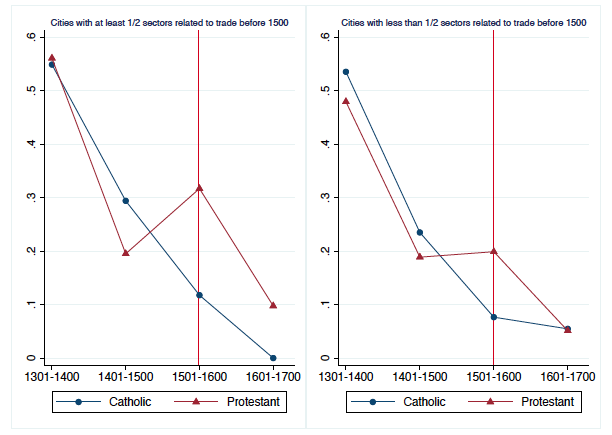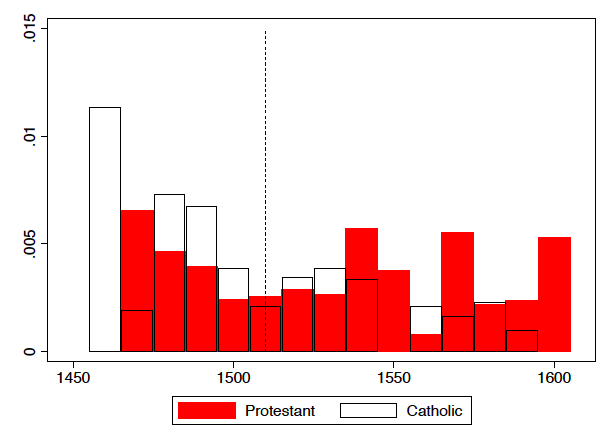Economic factors of anti-Semitism are often overlooked as academic research tends to focus on cultural and political determinants. Sascha O. Becker and Luigi Pascali in their BSE Working Paper (No.1060) “Religion, Division of Labor and Conflict: Anti-Semitism in Germany over 600 Years” assess how economic incentives have played a role in shaping the geography of anti-Semitism. They specifically focus on the complementarities in the labor market between a Jewish minority and the rest of the population to explain the variations in violence toward Jews over time.
A historical episode of division of labor and geography of anti-Semitism
In their paper, the authors study an historical episode in which the division of labor between the Jewish minority and the rest of the population played a crucial role in forming the geography of anti-Semitic inclinations. They analyze the years between 1300 and 1900 in Germany. In the first two centuries of this period, Jewish minority had a comparative advantage in moneylending, which is thought to have two reasons. First, the Catholic ban on usury ruled Catholics out from lending with interest while allowing the Jews to do so at the same time. Second, compared to the Catholic majority, Jewish minority had higher literacy rates and human capital levels.
After the Protestant Reformation took place in 1517, the German territory was divided between Catholics and Protestants. Protestant perspective on usury were less prohibitive, and Protestant moneylending was allowed. Also, Martin Luther encouraged his followers to advance education, reducing the human capital gap between Jewish minority and the Protestant majority. Therefore, while in Catholic regions complementarities between Catholics and Jews remained, in Protestant areas Jews lost their advantage in moneylending sector, which have resulted in increased competition between them and the majority leading to more hostile and intolerant behavior toward Jews.
In this line of thought, the authors show that following the Protestant Reformation, anti-Semitism increased in Protestant Germany relative to Catholic Germany, and this relative increase was more prominent in trade cities and cities in which Jewish moneylending was established before the Reformation.
The data
The authors construct two different data sets in their research, using data sources of Germania Judaica, Alicke (2008), Deutsches Städtebuch, and The Universal Short Title Catalogue (2012).
First, they bring together a panel dataset on pogroms and other anti-Semitic behavior of more than 2000 German cities with observations on each century from 1300 to 1900. In their main estimation sample, they use those cities that were founded before 1500, andthat have a recorded Jewish presence at least once, making for 1298 cities. They use two centuries before the Reformation (1300-1500) and two after the Reformation (1500-1700). Specifically, they define, century by century, the following variables: evidence of Jewish presence, the persecution of Jews, and Jewish lending activity. Moreover, they use as control variables in their regressions whether there was a battle near a city, whether the city was besieged, and the presence of a school in the city. These data are used to document that pogroms, the killings of Jews and expulsions of Jewish communities, increased in Protestant Germany relative to Catholic Germany following the Reformation.
Second, the authors bring together data on all known books printed in German cities between 1450 and 1600. They use these data to construct a panel measure of anti-Semitic attitudes in 10-year intervals, and they provide evidence of the change in these attitudes in Germany following the Protestant Reformation. They detect that the absolute number and the share of books with anti-Semitic titles printed in Protestant Germany increased relative to Catholic Germany following the Protestant Reformation.
Additionally, they collect further city-level data on the sectorial specialization of the city and on the presence of Jewish lending before the Reformation in order to test their theory that Reformation’s impact on anti-Semitism stems from the division of labor between the Jewish minority and the Christian majority, and not from other irrelevant channels.
City-level data
Figure 1 divides the sample cities depending on whether they were specialized in trade and trade-related services before the Reformation or not.
The authors claim that for Catholic cities there is a similar decline in pogroms between trade and non-trade cities throughout time. For cities that became Protestant, pogroms increased in the century of the Reformation. They find that this increase was four times larger in trade cities compared to non-trade cities. Among trade cities, cities that became Protestant used to be considerably less anti-Semitic towards the Jews before the Reformation compared to cities that stayed Catholic and became consistently more anti-Semitic in the century of the Reformation and in the following ones. Among non-trade cities, cities that became Protestant experienced a much smaller increase in anti-Semitism in the century of the Reformation, while anti-Semitism came back to the mean level in the following centuries.
They interpret this evidence as supporting the view that trade cities had larger returns to banking and a higher “need” for Jews compared to the other cities in pre-Reformation Germany.

The authors analyze the data in an instrumental variables framework where pre-Reformation trade specialization serves as an instrument for pre-Reformation Jewish lending. They find a statistically significant causal effect of pre-Reformation Jewish moneylending on the post-Reformation shift in anti-Semitism.
To sum up, the authors interpret these findings as evidence that with the Reformation Jews lost their comparative advantage in lending: this exposed them to competition with the Christian majority and led to an increase in ethnic and religious hostility toward the Jews.
Anti-Jewish sentiment in Books
Figure 2 shows the share of books with anti-Jewish titles published in Protestant and Catholic cities. Authors emphasize two distinct patterns in this figure. First, in the decades before the Reformation, there is an overall reduction in the share of anti-Jewish books, which reflects the reduction in anti-Jewish violence. Once the Reformation starts, this general decline in the share of anti-Jewish publications continues in Catholic cities but not in Protestant cities. As a result, starting from the 1540s, the share of anti-Jewish publications is generally higher in Protestant cities compared to Catholic cities. The regression analyses that the authors perform also indicate a shift in anti-Jewish sentiment towards Protestant cities following the Reformation.

This paper, “Religion, Division of Labor and Conflict: Anti-Semitism in Germany over 600 Years,” is forthcoming in American Economic Review.


